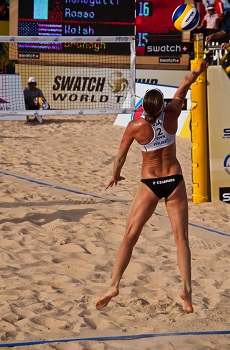Volleyball terms and definitions for success in volleyball.
Defining the “Spike”
Spiking is the most fun part of playing volleyball.
Players take an approach to get in position tospike.
When a hitter hits the ball really hard, this is called spiking.
Attacking the ball
Spiking is also referred to as attacking.
An “attack hit” is any ball that’s sent over the net. The better a team is at attacking, the more likely at team will win the rally and score.

“Spiking” a Volleyball
Attacks are performed in many ways…
- Tipping the ball. This is an attacking option for when an attacker wants to carefully place the ball into the opponents court. This is also for when a spike is difficult or nearly impossible perform. For example, if the set is too low or the attacker can’t find a hole in the block, the attacker may elect to tip instead of spike hard.
- Over head setting the ball over the net. This is usually for when the attacker is trying to be sneaky. Setting to deep corners, the middle of the court, or short to zones 4 or 2 can be difficult to defend.
- Setter dump. This is when the setter tries to be catch the opponent off-guard with a second ball attack.
- Attacking out of the back row. This play is often referred to as setting the “pipe” or “D” ball.
- Jump serving is also referred to as attacking. Jump serves are usually either floaters or hard topspin. Jump serving can be a very effective strategy for winning because volleyball is usually a contest between the servers and the passers.
If you enjoyed these tips and would like to keep it close to you at any time, just save this pin to your Pinterest Volleyball Training Board.

Setting a Ball
When the ball is directed to a teammate for a potential attack, this is referred to as a “set”.
Setting is the skill of using overhead finger action on a ball. Setting is the most accurate way of passing the ball to a teammate.
At competitive levels of volleyball, all teams have at least one player that specializes in setting. These players are called “setters”.
If possible, a setter on a team wants to set every ball that’s passed from a teammate.
The setter is kind of like a coach out on the court. Much like a quarterback in American football, the setter feeds the ball to teammates.
The setter directs the players and is in charge of running the team offense.
Other Volleyball Terms and Definitions
The following are important volleyball terms and definitions for understanding the game.
Line Up and Rotation. Every team has an official lineup and serving order. The line up is how the players start out on the court at the beginning of a game. The coach can change the line up each game.
Player Positions. There are 6 players on the court at a time. A team usually has either 1 or 2 setters. A team also has 2 middle hitters, 2 outside hitters, and 1 or 2 players playing the opposite position. There are also players on the bench that sub into the game. Players that sub in the game across the back row are defensive specialists. There’s also a position in volleyball that’s completely unique from any other player. This player is called the “libero”.
Sets and Matches. Volleyball terms and definitions for “sets” and “matches” will vary across different organizations. Volleyball games are called “sets”. Most competitive volleyball teams play “match play”. Matches usually consist of best of 3. It’s also common to play the best of 5.
Officiating Crew. The officials are made up of 2 referees (R1 and R2), line judges, a scorekeeper, and libero tracker.
Home › Volleyball Terms › Terms and Definitions
